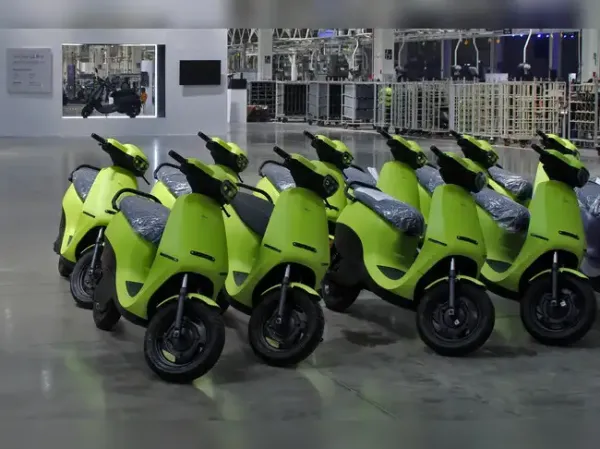The gap of just 526 units between Ola Electric and Ather Energy in July so far marks a sharp narrowing compared with June
Ola Electric’s shift from chasing growth to focusing on profitability has come at a cost. Its market share in the electric two-wheeler segment slipped to 17.2% as of July 27, down from 19.9% in June, as per Vahan data. Ather Energy, its listed rival, is now within striking distance, clocking 13,187 units this month for a 16.5% share.
The gap of just 526 units between Ola Electric and Ather Energy in July so far marks a sharp narrowing compared with June, when Ola Electric had sold over 5,000 units more than Ather Energy.
Ola Electric reported a net loss of Rs 428 crore on revenue of Rs 828 crore for the first quarter of FY26. Losses widened 23% from Rs 347 crore in the same quarter last year but shrank 51% from Rs 870 crore in the January-March period. Revenue rose 35% sequentially from Rs 611 crore but was down 49.6% year-on-year. Ather Energy is yet to report its financials for the April-June period.

Responding to queries sent by ET, Ravneet Phokela, chief business officer of Ather Energy, said that the recent growth in its numbers was on account of the launch of its family-oriented scooter series, Rizta, which has expanded its user base across new segments and geographies. Queries sent to Ola Electric, Bajaj Auto, and TVS Motor remained unanswered till press time.This shake-up in market positions comes amid rising concerns over China’s curbs on rare earth magnet exports, which are starting to hit electric two-wheeler sales in India. The segment has seen a 21.6% drop in volumes so far in July versus June. Even legacy players like TVS Motor and Bajaj Auto, which lead the category, have seen sharp month-on-month declines of 31% and 27.4%, respectively.Phokela of Ather Energy said the company has so far managed to avoid any major impact by balancing inventory between its manufacturing units and dealerships. “As an industry, all of us are also exploring alternative sources and technologies, but that's not ready at this point in time,” he said.
In a recent interview with ET, Rajiv Bajaj, managing director of Bajaj Auto, said August could be a “zero month” for its electric scooter Chetak and electric three-wheeler GoGo due to a shortage of rare earth magnets, making it the first automaker to halt production as a result of China’s export curbs on the key component.
Also Read: Bajaj Auto stares at big risk of 'zero' EV production in August due to China's rare earth move, MD Rajiv Bajaj
Ola Electric slips
The drop in Ola Electric’s market share and sales has come at a time when it has been grappling with a range of challenges, including scrutiny over sales data discrepancies, vehicle quality concerns and missing trade certificates at several of its retail outlets.
“Ola Electric has been grappling with the issues of quality historically, because of which the brand has taken a hit,” said Jay Kale, executive vice president of Elara Capital. “While they have mentioned in their earnings calls that their Gen 3 products have a much better quality, it will take time for that to reflect in the market and the word of mouth to spread.”
Ola’s stock has also underperformed since its listing. On Friday, it closed at Rs 41.2 on the BSE, well below the IPO price of Rs 76. In contrast, Ather’s shares closed at Rs 333.7, up from its IPO price of Rs 321.
In February, Ola Electric reported 25,000 vehicle sales in its filings, while Vahan data showed just 8,652 registrations. The discrepancy was attributed to a backlog caused by contract renegotiations with registration service providers Rosmerta and Shimnit India. However, the mismatch triggered inquiries from both the Ministry of Heavy Industries and the Ministry of Road Transport and Highways.
During the company’s June quarter earnings call, founder Bhavish Aggarwal said Ola Electric has transitioned from aggressive market penetration to a more balanced, profitable growth strategy. He noted that the industry is consolidating after a hyper-growth phase and is likely to see another surge in the near future. Also, he expects industry volumes to rise 40–50% during the upcoming festive season.
Rare earth crisis
Rare earth elements, a group of 17 crucial minerals, are essential in the manufacturing of EVs, electronics, and defence equipment. Earlier this month, ET reported that several EV makers, including Bajaj Auto, Ather Energy and TVS Motor are preparing to cut production amid prolonged supply disruptions of heavy rare earth magnets from China.
In a letter to shareholders after its June quarter results, Ola Electric said it has been working on motors without rare earth magnets for the past two years, and that the project was fast-tracked in April after China announced the curbs. The company added that these new motors will begin powering Ola Electric’s vehicles from the next quarter.
However, ramping up production of these alternative motors is no easy task. According to industry experts, developing rare earth magnet-less motors is time-consuming, involving multiple stages such as homologation, regulatory approvals, and testing.
The gap of just 526 units between Ola Electric and Ather Energy in July so far marks a sharp narrowing compared with June, when Ola Electric had sold over 5,000 units more than Ather Energy.
Ola Electric reported a net loss of Rs 428 crore on revenue of Rs 828 crore for the first quarter of FY26. Losses widened 23% from Rs 347 crore in the same quarter last year but shrank 51% from Rs 870 crore in the January-March period. Revenue rose 35% sequentially from Rs 611 crore but was down 49.6% year-on-year. Ather Energy is yet to report its financials for the April-June period.

Responding to queries sent by ET, Ravneet Phokela, chief business officer of Ather Energy, said that the recent growth in its numbers was on account of the launch of its family-oriented scooter series, Rizta, which has expanded its user base across new segments and geographies. Queries sent to Ola Electric, Bajaj Auto, and TVS Motor remained unanswered till press time.This shake-up in market positions comes amid rising concerns over China’s curbs on rare earth magnet exports, which are starting to hit electric two-wheeler sales in India. The segment has seen a 21.6% drop in volumes so far in July versus June. Even legacy players like TVS Motor and Bajaj Auto, which lead the category, have seen sharp month-on-month declines of 31% and 27.4%, respectively.Phokela of Ather Energy said the company has so far managed to avoid any major impact by balancing inventory between its manufacturing units and dealerships. “As an industry, all of us are also exploring alternative sources and technologies, but that's not ready at this point in time,” he said.
In a recent interview with ET, Rajiv Bajaj, managing director of Bajaj Auto, said August could be a “zero month” for its electric scooter Chetak and electric three-wheeler GoGo due to a shortage of rare earth magnets, making it the first automaker to halt production as a result of China’s export curbs on the key component.
Also Read: Bajaj Auto stares at big risk of 'zero' EV production in August due to China's rare earth move, MD Rajiv Bajaj
Ola Electric slips
The drop in Ola Electric’s market share and sales has come at a time when it has been grappling with a range of challenges, including scrutiny over sales data discrepancies, vehicle quality concerns and missing trade certificates at several of its retail outlets.
“Ola Electric has been grappling with the issues of quality historically, because of which the brand has taken a hit,” said Jay Kale, executive vice president of Elara Capital. “While they have mentioned in their earnings calls that their Gen 3 products have a much better quality, it will take time for that to reflect in the market and the word of mouth to spread.”
Ola’s stock has also underperformed since its listing. On Friday, it closed at Rs 41.2 on the BSE, well below the IPO price of Rs 76. In contrast, Ather’s shares closed at Rs 333.7, up from its IPO price of Rs 321.
In February, Ola Electric reported 25,000 vehicle sales in its filings, while Vahan data showed just 8,652 registrations. The discrepancy was attributed to a backlog caused by contract renegotiations with registration service providers Rosmerta and Shimnit India. However, the mismatch triggered inquiries from both the Ministry of Heavy Industries and the Ministry of Road Transport and Highways.
During the company’s June quarter earnings call, founder Bhavish Aggarwal said Ola Electric has transitioned from aggressive market penetration to a more balanced, profitable growth strategy. He noted that the industry is consolidating after a hyper-growth phase and is likely to see another surge in the near future. Also, he expects industry volumes to rise 40–50% during the upcoming festive season.
Rare earth crisis
Rare earth elements, a group of 17 crucial minerals, are essential in the manufacturing of EVs, electronics, and defence equipment. Earlier this month, ET reported that several EV makers, including Bajaj Auto, Ather Energy and TVS Motor are preparing to cut production amid prolonged supply disruptions of heavy rare earth magnets from China.
In a letter to shareholders after its June quarter results, Ola Electric said it has been working on motors without rare earth magnets for the past two years, and that the project was fast-tracked in April after China announced the curbs. The company added that these new motors will begin powering Ola Electric’s vehicles from the next quarter.
However, ramping up production of these alternative motors is no easy task. According to industry experts, developing rare earth magnet-less motors is time-consuming, involving multiple stages such as homologation, regulatory approvals, and testing.








